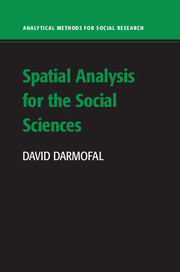
-
Select format
-
- Publisher:
- Cambridge University Press
- Publication date:
- 05 November 2015
- 29 October 2015
- ISBN:
- 9781139051293
- 9780521888264
- 9780521716383
- Dimensions:
- (228 x 152 mm)
- Weight & Pages:
- 0.48kg, 264 Pages
- Dimensions:
- (228 x 152 mm)
- Weight & Pages:
- 0.39kg, 259 Pages
You may already have access via personal or institutional login
Book description
Many theories in the social sciences predict spatial dependence or the similarity of behaviors at neighboring locations. Spatial Analysis for the Social Sciences demonstrates how researchers can diagnose and model this spatial dependence and draw more valid inferences as a result. The book is structured around the well-known Galton's problem and presents a step-by-step guide to the application of spatial analysis. The book examines a variety of spatial diagnostics and models through a series of applied examples drawn from the social sciences. These include spatial lag models that capture behavioral diffusion between actors, spatial error models that account for spatial dependence in errors, and models that incorporate spatial heterogeneity in the effects of covariates. Spatial Analysis for the Social Sciences also examines advanced spatial models for time-series cross-sectional data, categorical and limited dependent variables, count data, and survival data.
Reviews
'Do you collect all your data from just one place? Would the geography of what your research covers look like a single dot on a map? If so, then don't read David Darmofal's interesting and accessible book on spatial statistics. And definitely skip the practical discussion of software that shows you how to improve your statistical analyses to account for geographic dependencies.'
Gary King - Albert J. Weatherhead III University Professor, and Director, Institute for Quantitative Social Science, Harvard University, Massachusetts
'Spatial Analysis for the Social Sciences is an accessible ‘must-read’ so that scholars learn to recognize the dependencies in their data, how to test for these dependencies, and how to address them. Darmofal is convincing in his conclusion that all social science data are indeed spatial data.'
Janet M. Box-Steffensmeier - Vernal Riffe Professor of Political Science, Ohio State University
'In this detailed, thoughtful book, David Darmofal teaches us how to model data driven by geography, whether cholera outbreaks or presidential votes. This book maps out strategies to define spatial data and draw inferences. His work is thorough, his treatment of the subject is masterful, and students across the social sciences will benefit from this book. This is an exciting read for a methodologically sophisticated reader, providing fantastic illustrations.'
Betsy Sinclair - Washington University, St Louis
Contents
Metrics
Altmetric attention score
Full text views
Full text views help Loading metrics...
Loading metrics...
* Views captured on Cambridge Core between #date#. This data will be updated every 24 hours.
Usage data cannot currently be displayed.
Accessibility standard: Unknown
Why this information is here
This section outlines the accessibility features of this content - including support for screen readers, full keyboard navigation and high-contrast display options. This may not be relevant for you.
Accessibility Information
Accessibility compliance for the PDF of this book is currently unknown and may be updated in the future.


